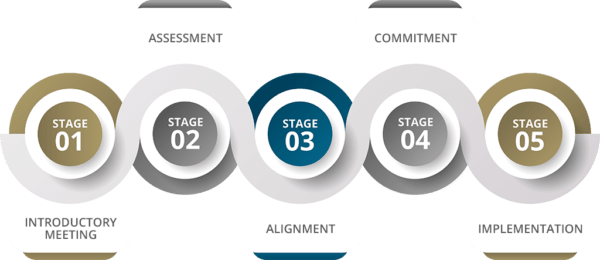Family Business Consulting Model

Most of our consulting engagements are implemented in five stages. The activities in these stages may overlap, but generally occur in the following sequence.
- We typically begin with an Introductory Meeting to get to know one another. In this meeting, we ascertain if we are the right consulting firm for you by listening to your objectives, gaining an understanding of your issues and concerns and sharing our approach to consultation. We share our understanding of family business dynamics and how we help families in business. Importantly, we learn whether we are comfortable working with each other. We then propose the scope of our work, business arrangements and timeframe. When we are aligned, we move to the assessment process.
- In the Assessment Stage, we begin our discovery, which includes interviewing family members, key employees and, in some cases, other advisors. We also review documents to help us become familiar with the entire family business system. Depending on your presenting issues, we may administer one of the Aspen questionnaires such as the Family Business Inventory, the Family Wealth Inventory, the Family Foundation Inventory or the Legacy Properties Inventory.These instruments yield reports with details about family and business strengths, vulnerabilities, knowledge gaps and issues regarding trust and fairness. These reports, in conjunction with individual interviews, lead us to a list of core issues for both your family and business. In the family retreat that follows, we prioritize the issues, share observations and recommendations and engage your family in developing the plan.By the end of the family retreat, we will have a list of prioritized goals and delegated responsibilities for reaching those goals. We often begin the alignment process during the retreat.
- The Alignment stage is designed to rebuild trust, clarify assumptions, reduce conflict and create better communication. In the process of alignment, family purpose, shared vision and values emerge and become the foundation of the stages that follow.
- The Commitment stage involves writing covenants, contracts or other agreements that reflect new boundaries and the commitments family members are making. These agreements may include a Family Mission Statement, a Statement of Vision, a Family Employment Policy, a Buy-Sell Agreement, a Shareholders’ Position Statement and/or other agreements and plans as necessary. Work on building trust and teamwork will continue during this stage.
- In the Implementation stage, systems of accountability, organizational structures and processes (e.g. Family Councils, Shareholder Groups, Estate Plans, etc.) are created, which reflect the maturation of both your family and your business. Ongoing collaboration to assure that change is fully implemented is often part of the individualized work we design with our clients.

